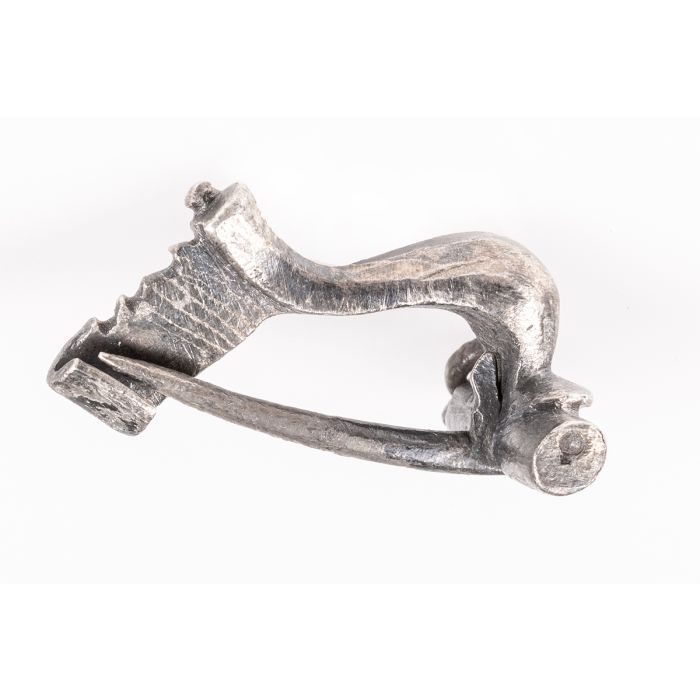Roman silver knee brooch
Price: on request
Sold
Object number
AR3050H
| Object: |
Roman knee fibula
|
| Material: |
Silver.
|
| Period: |
Roman Imperial period. 2nd cent. AD. |
| Description: |
Characteristic of this Roman fibula is the dramatic bend in its bow, which gives the class of knee fibulae its name. The head ends in a semicircular plate. The foot closes with a small decorative knob. The pin is attached to a crossbar at the head of the fibula by means of a hinge and is held at the tip by a long catch plate. The loop at one end of the cross bar is remarkable. A ring is still clamped into it. The loop was apparently used to secure the valuable brooch by attaching it to the cloths by a string. This type probably comes from the Danubian provinces of the Roman Empire. |
| Background: |
Fibulae were more than just brooches or pins for fastening garments. They were jewellery and status symbol and were worn prominently near the shoulder. This explains the abundance of fashionable shapes and styles that can be observed with surviving ancient pieces. They vary with region, era and social background of the wearer. Modern archaeology uses that distinctiveness to quickly attribute an archaeological find whenever a fibula is part of it.
|
| Dimensions: |
28mm length. 21mm width.
|
| Condition: |
Very good condition. Body of the fibula fully intact including decorations. Original pin is preserved, also a loop and ring next to the crossbar still preserved.
|
| Provenance: |
Acquired by us in 2020 on the German art market. Previously in the Austrian private collection M. S., exported from Austria to Germany in 2019 with approval from the Austrian Federal Monuments Office. Acquired into the collection in the 1970ies.
|
| References: |
Cf. R. Hattatt, A Visual Catalogue of Richard Hattatt's Ancient Brooches, p. 334, no. 467. Cf. S. Redic, Finding of roman brooches in the cemeteries of Viminacium, plate XVI, no. 171. |
| Literature: |
A superb and compact overview on the subject of ancient fibulae is given by R. Heynowski in his book "Fibeln - erkennen, bestimmen, beschreiben" (Deutscher Kunstverlag, 2012, German language).
|
| Authenticity: |
We unconditionally guarantee the authenticity of every artefact, all items are subject to our lifetime return policy on authenticity.
|


